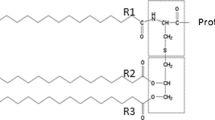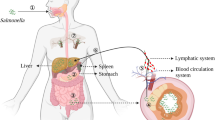Abstract
The aim of the present study was to identify released proteins of Streptococcus agalactiae and to investigate their immunoreactivity with human sera to determine whether such proteins might be viable as carrier proteins in conjugate vaccines. Infections with S. agalactiae are the leading cause of sepsis and meningitis in neonates. Vaccination of women of childbearing age would be a desirable alternative to intrapartum antibiotic prophylaxis, but factors that mediate S. agalactiae invasive disease and virulence are poorly defined. Capsule-based vaccines have shown only low immunogenicity to date, and interest has shifted towards S. agalactiae proteins, either as candidate vaccine antigens or as carrier proteins for serotype-specific S. agalactiae polysaccharides. In this study, some major released proteins of S. agalactiae could be identified, including molecules known to be present on the surface of bacterial cells but not previously described as released proteins, such as CAMP factor, a phosphocarrier protein, aldolase, enolase, PcsB, and heat-shock protein 70. Serotype-specific differences in the protein patterns of extracellular products and immunoreactivity with human sera could be detected by SDS-PAGE and Western blot. The identification of unexpected released proteins may indicate secondary functions for these proteins. In addition, the widespread immunoreactivity of these proteins with human sera as shown by Western blot indicates that released proteins may be promising candidates as carrier proteins in conjugate vaccines.




Similar content being viewed by others
References
Hussain SM, Luedtke GS, Baker CJ, Schlievert PM, Leggiadro RJ (1995) Invasive group B streptococcal disease in children beyond early infancy. Pediatr Infect Dis J 14:278–281
Schrag SJ, Zywicki S, Farley MM, Reingold AL, Harrison LH, Lefkowitz LB, Hadler JL, Danila R, Cieslak PR, Schuchat A (2000) Group B streptococcal disease in the era of intrapartum antibiotic prophylaxis. N Engl J Med 342:15–20
Farley MM, Harvey RC, Stull T, Smith JD, Schuchat A, Wenger JD, Stephens DS (1993) A population-based assessment of invasive disease due to group B streptococcus in nonpregnant adults. N Engl J Med 328:1807–1811
Berner R (2002) Group B streptococci in pregnancy and infancy. Curr Opin Infect Dis 15:307–313
Rubens CE, Wessels MR, Heggen LM, Kasper DL (1987) Transposon mutagenesis of type III group B streptococcus: correlation of capsule expression with virulence. Proc Natl Acad Sci 84:7208–7212
Wessels MR, Rubens CE, Benedi VJ, Kasper DL (1989) Definition of a bacterial virulence factor: sialylation of the group B streptococcal capsule. Proc Natl Acad Sci 86:8983–8987
Lancefield RC, McCarty M, Everly WN (1975) Multiple mouse-protective antibodies directed against group B streptococci. Special reference to antibodies effective against protein antigens. J Exp Med 142:165–179
Larsson C, Stalhammar-Carlemalm M, Lindahl G (1999) Protection against experimental infection with group B streptococcus by immunization with a bivalent protein vaccine. Vaccine 17:454–458
Michel JL, Madoff LC, Kling DE, Kasper DL, Ausubel FM (1991) Cloned alpha and beta C-protein antigens of group B streptococci elicit protective immunity. Infect Immun 59:2023–2028
Stalhammar-Carlemalm M, Stenberg L, Lindahl G (1993) Protein rib: a novel group B streptococcal cell surface protein that confers protective immunity and is expressed by most strains causing invasive infections. J Exp Med 177:1593–1603
Martin D, Rioux S, Gagnon E, Boyer M, Hamel J, Charland N, Brodeur BR (2002) Protection from group B streptococcal infection in neonatal mice by maternal immunization with recombinant Sip protein. Infect Immun 70:4897–4901
Kreikemeyer B, McIver KS, Podbielski A (2003) Virulence factor regulation and regulatory networks in Streptococcus pyogenes and their impact on pathogen-host interactions. Trends Microbiol 11:224–232
Berner R, Bender A, Rensing C, Forster J, Brandis M (1999) Low prevalence of the immunoglobulin-A-binding beta antigen of the C protein among Streptococcus agalactiae isolates causing neonatal sepsis. Eur J Clin Microbiol Infect 18:545–550
Hughes MJ, Moore JC, Lane JD, Wilson R, Pribul PK, Younes ZN, Dobson RJ, Everest P, Reason AJ, Redfern JM, Greer FM, Paxton T, Panico M, Morris HR, Feldman RG, Santangelo JD (2002) Identification of major outer surface proteins of Streptococcus agalactiae. Infect Immun 70:1254–1259
Pancholi V, Fischetti VA (1997) A novel plasminogen/plasmin binding protein on the surface of group A streptococci. Adv Exp Med Biol 418:597–599
Pancholi V, Fischetti VA (1998) Alpha-enolase, a novel strong plasmin(ogen) binding protein on the surface of pathogenic streptococci. J Biol Chem 273:14503–14515
Lee KW, Thakur A, Karim AM, LoVerde PT (1995) Immune response to Schistosoma mansoni phosphoglycerate kinase during natural and experimental infection: identification of a schistosome-specific B-cell epitope. Infect Immun 63:4307–4310
Winram SB, Lottenberg R (1996) The plasmin-binding protein Plr of group A streptococci is identified as glyceraldehyde-3-phosphate dehydrogenase. Microbiology 142:2311–2320
Fontan PA, Pancholi V, Nociari MM, Fischetti VA (2000) Antibodies to streptococcal surface enolase react with human alpha-enolase: implications in poststreptococcal sequelae. J Infect Dis 182:1712–1721
Gase K, Gase A, Schirmer H, Malke H (1996) Cloning, sequencing and functional overexpression of the Streptococcus equisimilis H46A gapC gene encoding a glyceraldehyde-3-phosphate dehydrogenase that also functions as a plasmin(ogen)-binding protein. Purification and biochemical characterization of the protein. Eur J Biochem 239:42–51
Pancholi V, Fischetti VA (1992) A major surface protein on group A streptococci is a glyceraldehyde-3-phosphate-dehydrogenase with multiple binding activity. J Exp Med 176:415–426
Nelson D, Goldstein JM, Boatright K, Harty DW, Cook SL, Hickman PJ, Potempa J, Travis J, Mayo JA (2001) pH-regulated secretion of a glyceraldehyde-3-phosphate dehydrogenase from Streptococcus gordonii FSS2: purification, characterization, and cloning of the gene encoding this enzyme. J Dent Res 80:371–377
Yamakami K, Yoshizawa N, Wakabayashi K, Takeuchi A, Tadakuma T, Boyle MD (2000) The potential role for nephritis-associated plasmin receptor in acute poststreptococcal glomerulonephritis. Methods 21:185–197
Modun B, Williams P (1999) The staphylococcal transferrin-binding protein is a cell wall glyceraldehyde-3-phosphate dehydrogenase. Infect Immun 67:1086–1092
Reinscheid DJ, Gottschalk B, Schubert A, Eikmanns BJ, Chhatwal GS (2001) Identification and molecular analysis of PcsB, a protein required for cell wall separation of group B streptococcus. J Bacteriol 183:1175–1183
Lemos JA, Giambiagi-Demarval M, Castro AC (1998) Expression of heat-shock proteins in Stretococcus pyogenes and their immunoreactivity with sera from patients with streptococcal diseases. J Med Microbiol 47:711–715
Lang S, Palmer M (2003) Characterization of Streptococcus agalactiae CAMP factor as a pore-forming toxin. J Biol Chem 278:38167–38173
Skalka B, Smola J (1981) Lethal effect of CAMP-factor and UBERIS-factor—a new finding about diffusible exosubstances of Streptococcus agalactiae and Streptococcus uberis. Zentralbl Bakteriol A 249:190–194
Jurgens D, Sterzik B, Fehrenbach FJ (1987) Unspecific binding of group B streptococcal cocytolysin (CAMP factor) to immunoglobulins and its possible role in pathogenicity. J Exp Med 165:720–735
Fontaine MC, Perez-Casal J, Song XM, Shelford J, Willson PJ, Potter AA (2002) Immunisation of dairy cattle with recombinant Streptococcus uberis GapC or a chimeric CAMP antigen confers protection against heterologous bacterial challenge. Vaccine 20:2278–2286
Baker CJ, Edwards MS, Kasper DL (1987) Immunogenicity of polysaccharides from type III, group B streptococcus. J Clin Invest 61:1107–1110
Paoletti LC, Madoff LC (2002) Vaccines to prevent neonatal GBS infection. Semin Neonatol 7:315–323
Baker CJ, Rench MA, Edwards MS, Carpenter RJ, Hays BM, Kasper DL (1988) Immunization of pregnant women with a polysaccharide vaccine of group B streptococcus. N Engl J Med 319:1180–1185
Gravekamp C, Kasper DL, Paoletti LC, Madoff LC (1999) Alpha C protein as a carrier for type III capsular polysaccharide and as a protective protein in group B streptococcal vaccines. Infect Immun 67:2491–2496
Author information
Authors and Affiliations
Corresponding author
Additional information
The authors declare that the experiments comply with the current laws of the country in which they were performed, i.e., Germany.
Rights and permissions
About this article
Cite this article
Fluegge, K., Schweier, O., Schiltz, E. et al. Identification and immunoreactivity of proteins released from Streptococcus agalactiae. Eur J Clin Microbiol Infect Dis 23, 818–824 (2004). https://doi.org/10.1007/s10096-004-1229-y
Published:
Issue Date:
DOI: https://doi.org/10.1007/s10096-004-1229-y




